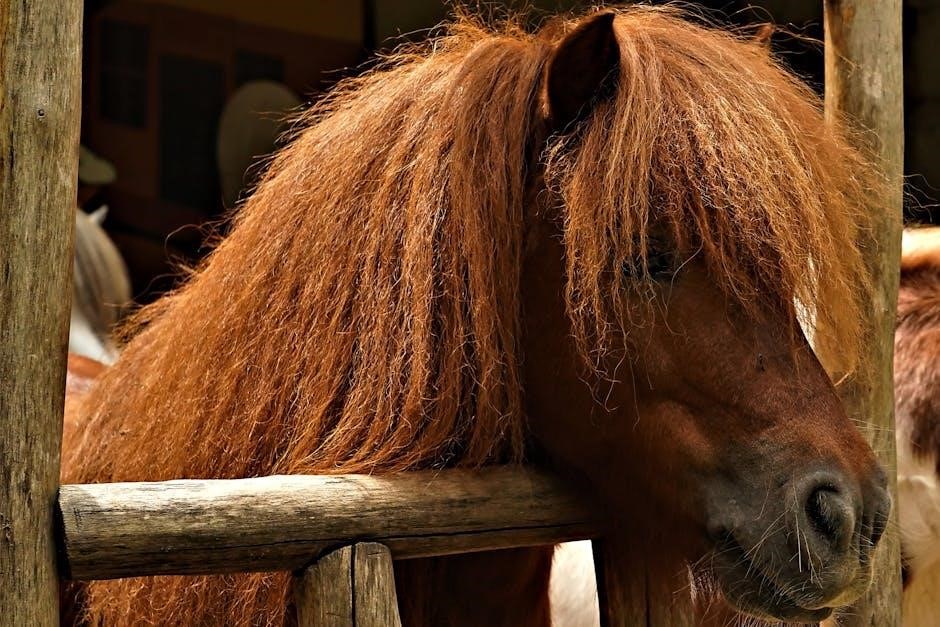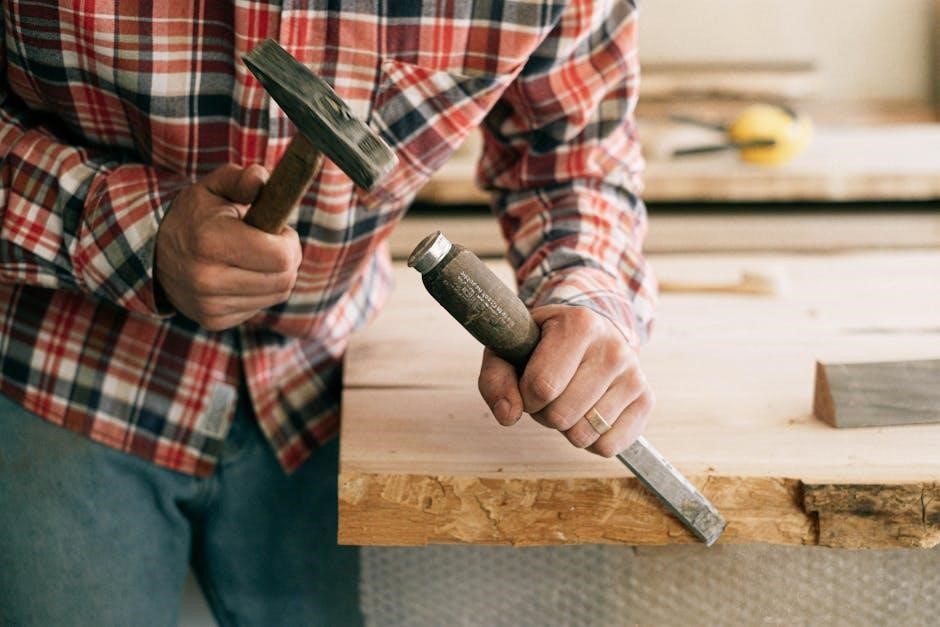Welcome to the Troy Bilt Pony Tiller Owner’s Manual! This guide provides essential information for safe and effective operation, maintenance, and troubleshooting of your tiller. Engineered for excellent performance, this manual ensures you maximize efficiency while maintaining safety standards. Thank you for choosing Troy Bilt!
Product Overview
The Troy Bilt Pony Tiller is a reliable and durable gardening tool designed to simplify soil preparation and tilling tasks. Built with a powerful 5HP Briggs & Stratton engine, it ensures efficient performance for small to medium-sized gardens. Its compact design makes it easy to maneuver, while the robust tines handle tough soil with ease. The tiller is engineered to deliver consistent results, whether breaking up clay soil or aerating garden beds. With a focus on user-friendly operation, it features intuitive controls and adjustable settings to suit various tilling needs. Regular maintenance, as outlined in the manual, ensures optimal performance and extends the product’s lifespan. Troy Bilt has included comprehensive resources, such as detailed diagrams and troubleshooting guides, to support users in achieving the best results. This tiller is a versatile and essential tool for gardeners seeking to enhance their yard care routine.
Key Features of the Troy Bilt Pony Tiller
The Troy Bilt Pony Tiller boasts several key features that make it a standout choice for gardeners. Its powerful 5HP Briggs & Stratton engine provides consistent power for tackling tough soil conditions. The tiller features adjustable tilling widths, allowing users to customize their work based on the size of their garden beds. The tines are designed for deep penetration, ensuring effective soil preparation and aeration. Additionally, the tiller includes a reverse gear, making it easier to maneuver in tight spaces. The ergonomic handle is designed for comfort, reducing fatigue during extended use. The tiller also comes with a comprehensive manual that includes detailed diagrams and troubleshooting guides. Troy Bilt has ensured that the product is both durable and user-friendly, making it a reliable choice for gardeners. Regular maintenance, as outlined, ensures the tiller continues to perform at its best. With these features, the Troy Bilt Pony Tiller is an excellent addition to any gardening toolkit.
Importance of Reading the Manual
Reading the Troy Bilt Pony Tiller owner’s manual is essential for ensuring safe and effective operation. The manual provides critical information about the tiller’s features, proper usage, and maintenance requirements. It outlines safety precautions to prevent accidents and offers guidance on troubleshooting common issues. Understanding the manual helps users optimize the tiller’s performance and extend its lifespan. Additionally, the manual includes warranty details and customer support information, which are vital for resolving any concerns. By following the instructions, users can avoid costly repairs and ensure compliance with manufacturer recommendations. The manual also provides diagrams and step-by-step instructions for assembly and maintenance, making it an indispensable resource for both new and experienced users. Taking the time to thoroughly review the manual ensures a smooth and efficient gardening experience. It is a cornerstone for getting the most out of the Troy Bilt Pony Tiller while maintaining safety and productivity.

Safety Precautions
Always wear protective gear, ensure the area is clear of debris, and keep children away. Follow proper handling techniques to avoid accidents. Regularly inspect the tiller for damage or wear.
General Safety Tips for Operating the Tiller
Always wear protective gear, including gloves, safety glasses, and sturdy footwear, to minimize injury risks. Ensure the area is clear of debris, rocks, and obstructions before tilling. Keep children and pets at a safe distance from the operating machine. Never operate the tiller near open flames or sparks, as it may ignite flammable materials. Maintain a firm grip on the handles to control the tiller’s movement and avoid losing balance. Avoid overreaching or stretching while operating, as this can lead to loss of control. Never leave the tiller unattended while it is running. Be aware of your surroundings, including overhead obstacles and nearby bystanders. Always follow the manufacturer’s guidelines for maximum load and operating conditions. Ensure the tiller is on level ground before starting to prevent tipping. Familiarize yourself with the controls and emergency stop procedures before use. Regularly inspect the machine for damage or wear to ensure safe operation.
Protective Gear Recommendations
Wearing the right protective gear is essential when operating the Troy Bilt Pony Tiller to ensure safety and prevent injuries. Always wear safety glasses or goggles to protect your eyes from flying debris. A dust mask is recommended to avoid inhaling dust and dirt kicked up during tilling. Durable gloves, such as work gloves, are necessary to improve grip and protect your hands from blisters or cuts. Steel-toe boots or sturdy footwear with good traction are crucial to prevent foot injuries. Additionally, consider wearing a hat and sunscreen to protect yourself from the sun. Long sleeves and pants can help prevent skin irritation from debris. If needed, use a face shield for extra protection. Ensure all protective gear fits properly and meets safety standards. Regularly inspect your gear for wear and tear to maintain its effectiveness. By wearing the appropriate protective equipment, you can minimize risks and operate the tiller safely and confidently.
Identifying Potential Hazardous Situations
When operating the Troy Bilt Pony Tiller, it’s crucial to identify and mitigate potential hazardous situations to ensure safe and effective use. Be aware of uneven terrain, as rocks, roots, or holes can cause the tiller to jerk or tip over. Avoid tilling near loose debris or obstacles like fences, trees, or garden beds, as they can cause accidents or damage; Never operate the tiller near children, pets, or bystanders, as they may unintentionally enter the work area. Be cautious of wet or slippery soil, as it can reduce traction and lead to loss of control. Additionally, avoid overreaching or leaning too far forward, as this can cause imbalance. Always turn off the engine and engage the brake when leaving the tiller unattended. Stay alert for loose clothing or long hair that could get caught in moving parts. Finally, never operate the tiller in poor visibility or adverse weather conditions. Being proactive in identifying these risks ensures a safer and more efficient tilling experience.

Assembly and Initial Setup
The assembly process begins with unpacking and inventorying all parts. Essential tools like a socket wrench and screwdrivers are required. Follow the manual’s guidance to ensure correct assembly. Proper setup ensures optimal performance and safety.
Unpacking and Inventory of Parts
Begin by carefully unpacking the Troy Bilt Pony Tiller from its shipping container. Inspect the unit for any visible damage during transit. Next, verify the completeness of the shipment by cross-referencing the included parts with the detailed inventory list provided in the manual. Ensure all major components, such as the tine assembly, handlebars, and engine housing, are accounted for. Additionally, check for smaller hardware items like bolts, nuts, and washers, as these are essential for proper assembly. If any parts are missing or damaged, contact Troy Bilt customer support immediately to resolve the issue. Organize the parts in a clean, dry workspace to streamline the assembly process. This step ensures a smooth and efficient setup experience.
Hardware and Tools Required for Assembly
Before assembling the Troy Bilt Pony Tiller, gather all necessary tools and hardware to ensure a smooth process. You will need a socket set, including 9/16″, 3/4″, and 1″ sockets, as well as wrenches (adjustable and box-end) for securing bolts. A screwdriver set, including Phillips and flathead drivers, is essential for various fasteners. Pliers and a torque wrench may also be required for specific adjustments. Additionally, ensure you have the hardware provided with the tiller, such as bolts, nuts, washers, and cotter pins, which are critical for securing components like the handlebars and tine assembly. Refer to the manual for a detailed list of hardware and tools to avoid missing any items. Organize the parts and tools in a clean workspace to streamline the assembly process. Optional tools, such as a work light or torque multiplier, can enhance efficiency but are not mandatory. Always follow the manual’s instructions for proper torque specifications and assembly sequences.
Step-by-Step Assembly Instructions
Begin by carefully unpacking the Troy Bilt Pony Tiller and verifying all parts against the inventory list provided in the manual. Start by attaching the handlebars to the main frame using the bolts and nuts from the hardware kit. Tighten securely but do not overtighten at this stage. Next, mount the engine to the frame by aligning the brackets and securing with the provided bolts. Ensure the engine is level and properly aligned before tightening.
Install the tine assembly by attaching the tines to the tiller shaft. Use the cotter pins to secure the tines in place. Afterward, attach the belt guard to protect the drive belt from debris. Finally, connect the throttle and choke cables to the engine, ensuring they are properly routed and secured. Double-check all connections and tighten any loose bolts. Refer to the manual for specific torque specifications and assembly diagrams to ensure accuracy. Once assembled, perform a final inspection to confirm all components are securely fastened and properly aligned before first use.

Operating the Tiller
Operate the Troy Bilt Pony Tiller by first ensuring the area is clear. Start the engine, engage the tines, and adjust speed with the control lever. Maintain balance and shut off when done.
Pre-Operation Checks to Ensure Safety
Before operating the Troy Bilt Pony Tiller, perform a thorough pre-operation check to ensure safety and proper functionality. Start by inspecting the oil and fuel levels, ensuring they are at the recommended levels. Check the tires for proper inflation and the handles for tightness. Inspect the tines and blades for damage or wear, as damaged parts can pose a hazard. Ensure all bolts and screws are securely tightened. Look for any signs of wear on belts or cables and replace them if necessary. Verify that the throttle and brake controls are functioning correctly. Finally, clear the area of debris, rocks, or obstacles to prevent accidents. Always wear recommended protective gear, such as gloves and safety goggles, before starting the tiller. By following these steps, you can ensure a safe and efficient tilling experience.
Starting and Stopping the Engine
To start the Troy Bilt Pony Tiller, ensure the choke is in the “start” position and the throttle is set to the “slow” setting. Prime the engine by pressing the primer bulb 2-3 times until it feels resistant. Pull the starter cord firmly until the engine roars to life. Once running, gradually move the choke to the “run” position and adjust the throttle as needed for your tilling speed.
To stop the engine, allow it to idle for a few seconds to cool down. Then, turn the ignition switch to the “off” position or engage the kill switch. Always disengage the tines before stopping the engine. Ensure the tiller comes to a complete stop before leaving it unattended. Regularly check the ignition and kill switch for proper function to ensure safe operation. Always follow these steps to avoid accidental starts or engine damage.
Effective Tilling Techniques and Strategies

For optimal results with your Troy Bilt Pony Tiller, start by preparing the soil. Remove debris, rocks, and weeds to ensure smooth tilling. Begin tilling in small, manageable sections, working in uniform passes. Overlap each pass slightly to ensure even soil breakdown. Maintain a steady, forward pace, keeping the tiller upright to prevent the tines from digging too deeply. Apply gentle to moderate pressure, depending on soil hardness;
When tilling, focus on breaking up clods and aerating the soil. If encountering hard-packed soil, make multiple passes at a shallower depth before increasing depth. For mulching, till organic matter into the soil to improve fertility. Avoid over-tilling, as it can damage soil structure. Use the reverse tine function for tough spots or compacted areas. Always keep the tines sharp for efficient performance. By following these techniques, you’ll achieve a well-prepared garden bed for planting. Regular practice will help refine your skills and maximize the tiller’s efficiency.

Maintenance and Upkeep
Regularly check and replace air filters, inspect tires, and clean the tiller after use. Lubricate moving parts and tighten bolts as needed. Schedule professional servicing every 50 hours for optimal performance. Refer to the manual for detailed maintenance schedules and tips to extend the lifespan of your Troy Bilt Pony Tiller.

Regular Maintenance Tasks for Optimal Performance
Regular maintenance is essential to ensure your Troy Bilt Pony Tiller operates efficiently and lasts for years. Begin by checking and replacing the air filter every 10 hours of use to maintain proper engine airflow. Change the engine oil every 25 hours or at the start of each gardening season to keep the motor running smoothly. Inspect the tires regularly and maintain the recommended pressure to ensure stability and traction. Clean the tines after each use to prevent soil buildup, and sharpen them annually to maintain tilling effectiveness. Lubricate all moving parts, such as cables and belts, every 50 hours to reduce wear and tear. Additionally, inspect the bolts and connections for tightness and tighten them as needed to prevent vibration damage. Refer to the manual for specific maintenance schedules and guidelines tailored to your tiller model.
Oil Change and Lubrication Procedures
Regular oil changes and proper lubrication are critical for maintaining the performance and longevity of your Troy Bilt Pony Tiller. Start by warming up the engine for a few minutes to circulate the oil. Locate the oil drain plug underneath the engine and position a drain pan to catch the old oil. Remove the plug, allow the oil to drain completely, and reinstall the plug securely. Refill the engine with the recommended oil type and viscosity, as specified in the manual. Next, lubricate all moving parts, such as the pivot points, cables, and gearboxes, using a high-quality grease or silicone-based lubricant. Ensure the tine shaft and bearings are well-lubricated to reduce friction and wear. Refer to the manual for specific locations and quantities. After completing these steps, start the engine and check for any leaks. Proper lubrication ensures smooth operation and extends the life of your tiller.
Blade and Tine Maintenance and Sharpening
Proper maintenance of the blades and tines is essential for the Troy Bilt Pony Tiller to function efficiently. Regularly inspect the blades and tines for damage, wear, or bending. Replace any damaged parts immediately to avoid further issues. Clean the blades and tines after each use to remove dirt and debris, which can hinder performance. Use a wire brush to scrub away soil, and apply a mild detergent if necessary. Sharpening the blades and tines periodically ensures optimal tilling results. Use a file or grinder to maintain a sharp edge, following the manufacturer’s recommended angle. Always wear protective gloves and eyewear during sharpening. After sharpening, check the balance of the blades to ensure even tilling. Store the tiller with clean, dry blades to prevent rust. Apply a light coat of oil to the tines and blades during storage to maintain their condition. Regular maintenance and sharpening will extend the life of your tiller and enhance its performance in the garden.

Troubleshooting Common Issues
Troubleshooting common issues with the Troy Bilt Pony Tiller involves identifying problems like engine malfunction, tine jamming, or uneven tilling. Check for clogged air filters, low fuel, or damaged belts. Ensure proper tension and alignment of belts. If issues persist, consult the manual or contact customer support for assistance. Regular maintenance often prevents these problems. Always follow safety guidelines when diagnosing and fixing issues.
Identifying and Diagnosing Common Problems
Identifying and diagnosing common issues with the Troy Bilt Pony Tiller is crucial for maintaining its performance. Start by observing unusual behaviors, such as engine stalling, uneven tilling, or excessive vibration. Check the air filter for cleanliness and ensure proper fuel levels. Inspect the tines for debris or damage, as clogged or bent tines can disrupt operation. Verify that all belts and cables are properly aligned and not worn. If the tiller vibrates excessively, check for imbalanced or loose components. Refer to the manual for specific troubleshooting guides tailored to your model. Pay attention to error sounds or unusual smells, as these can indicate underlying problems. Regularly inspecting the machine helps identify issues early, preventing costly repairs. Always follow safety precautions when diagnosing and addressing problems to avoid accidents. If unsure, consult the manual or contact Troy Bilt support for professional assistance.
Troubleshooting Engine and Tine Issues
Troubleshooting engine and tine issues on the Troy Bilt Pony Tiller ensures optimal performance. If the engine fails to start, check the spark plug for damage or fouling and ensure the air filter is clean. Verify fuel levels and quality, as stale or incorrect fuel can cause issues. If the engine stalls during operation, inspect the carburetor for blockages or misadjustment. For tine-related problems, ensure they are properly engaged and not obstructed by debris. If tines vibrate excessively, check for balance or wear. Uneven tilling may indicate dull or damaged tines, which require sharpening or replacement. Consult the manual for specific troubleshooting steps and diagrams. Always use genuine Troy Bilt parts for repairs to maintain warranty validity. If issues persist, contact customer support for professional assistance. Regular maintenance and inspections can prevent many of these problems, ensuring your tiller operates efficiently season after season.
Repair and Replacement Guidelines
When repairing or replacing parts on your Troy Bilt Pony Tiller, always refer to the manual for specific instructions; Identify the faulty component and order genuine Troy Bilt replacement parts to ensure compatibility and maintain warranty validity. Before starting any repair, disconnect the spark plug to prevent accidental startups. For major repairs, such as engine overhauls or tine replacements, follow the step-by-step procedures outlined in the manual. Apply lubricants to moving parts as specified to ensure smooth operation. If a part cannot be repaired, replace it promptly to avoid further damage. After completing repairs, test the tiller on a small area to ensure proper function. Keep track of all maintenance and repairs for future reference. If unsure about any procedure, contact Troy Bilt customer support or consult a certified technician. Proper repair and replacement practices will extend the lifespan of your tiller and maintain its performance.

Warranty and Support
Troy Bilt Pony Tiller owners are supported by a comprehensive warranty program. For detailed warranty terms, repair options, and customer service contact information, refer to the manual or visit the official Troy Bilt website.

Understanding the Warranty Terms and Conditions
The Troy Bilt Pony Tiller is backed by a limited warranty that covers defects in materials and workmanship for a specified period. The warranty typically includes coverage for the engine and other components, with varying durations depending on the part. To ensure eligibility, users must register their product and retain the purchase receipt. The warranty does not cover damage caused by misuse, improper maintenance, or normal wear and tear. It’s essential to review the terms thoroughly to understand what is included and excluded. Proper maintenance, as outlined in the manual, is required to maintain warranty validity. For specific details, refer to the warranty section in the manual or contact Troy Bilt support. Understanding these terms ensures owners can address issues promptly and make informed decisions about repairs or replacements.
Contacting Troy Bilt Customer Support
To address questions, concerns, or issues with the Troy Bilt Pony Tiller, customers can contact Troy Bilt’s dedicated customer support team. The most convenient methods include calling their customer service hotline, available Monday through Friday during business hours, or submitting an inquiry through the official Troy Bilt website. Additionally, live chat support is often available for immediate assistance. When reaching out, it’s advisable to have the product model number, serial number, and purchase date ready to expedite the process. Representatives are trained to provide troubleshooting guidance, warranty support, and repair options. For non-urgent matters, customers can also email the support team, typically receiving a response within 24 to 48 hours. Troy Bilt also offers an extensive FAQ section and downloadable resources on their website to help users resolve common issues independently. By utilizing these support channels, owners can ensure their Troy Bilt Pony Tiller operates effectively and efficiently.
Accessing Additional Resources and Manuals
For users seeking additional resources and manuals for the Troy Bilt Pony Tiller, Troy Bilt provides a variety of options to ensure optimal use and maintenance of the product. The official Troy Bilt website is the primary source for downloadable manuals, guides, and troubleshooting materials. By visiting the website and navigating to the support section, users can easily locate and download the owner’s manual in PDF format. Additionally, the site offers supplementary resources such as troubleshooting guides, maintenance tips, and repair instructions. To access these materials, users should have a stable internet connection and a compatible PDF viewer installed on their device. For further assistance, Troy Bilt also provides contact information for customer support, allowing users to request printed copies or additional guidance. These resources ensure that users can resolve issues, perform maintenance, and maximize the performance of their Troy Bilt Pony Tiller.
